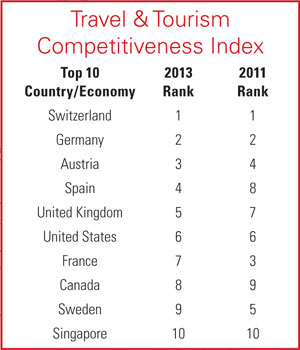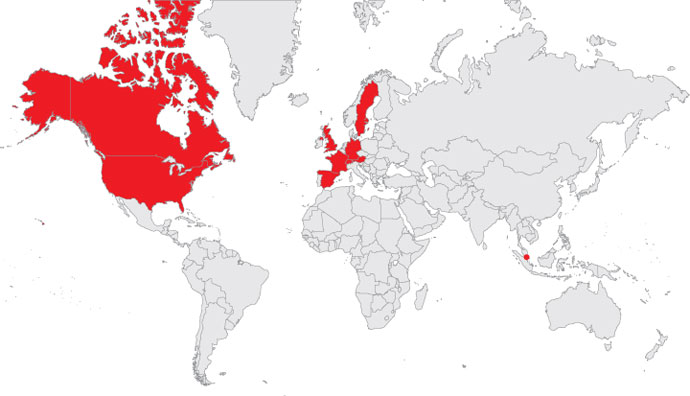Switzerland, Germany and Austria lead the world in terms of their travel and tourism industry competitiveness with Spain, the United Kingdom, the United States, France, Canada, Sweden and Singapore completing the top 10, according to the fifth Travel & Tourism Competitiveness Report, released in March by the World Economic Forum.
The biennial report, published under the theme, Reducing Barriers to Economic Growth and Job Creation, sees considerable movement in the Travel & Tourism Competitiveness Index’s top 10 countries. France fell four places from third in 2011 to seventh, while Spain climbed to fourth from eighth. Also showing strong improvement were the United Kingdom — up two places to fifth — and Canada, up one place to eighth.

Alongside Switzerland and Germany, the United States and Singapore maintained their positions, in sixth and 10th places, respectively. Sweden, the only other country in the top 10 to fall, dropped from fifth to ninth.
Among developed economies, New Zealand and Japan improved strongly; the former climbing to 12th from 19th and the latter moving up eight positions to 14th. Emerging market economies reported mixed levels of progress, with India, Brazil and South Africa among the BRICS nations moving up in the rankings. In this category, rising stars include Panama, climbing from 56th to 37th, and the Philippines, which climbed from 94th to 82nd on the back of policy improvements supporting the industry.
As well as providing insight into how countries are fostering the development of their travel & tourism industry, the report also offers a snapshot on the health of the industry and its role in driving global economic growth. With travel and tourism accounting for one in 11 jobs globally, the report highlights that the industry has proven resilient during the global economic downturn and can be a key factor in paving the way for developing and emerging markets to diversify into higher value economic activities.
“Industry resilience has been driven by the growth of the middle class in emerging markets, although advanced economies too are displaying positive momentum. Better policies, harnessing technology and facilitating the movement of people over borders will allow the industry to capitalize on this tailwind and support rising prosperity into the future,” said Jennifer Blanke, chief economist and head of the Global Competitiveness and Benchmarking Network at the World Economic Forum.

“The travel and tourism industry has weathered the global downturn and is now playing an important role in helping tackle serious global challenges, including youth unemployment, economic development and environmental sustainability. The challenge for the industry and its stakeholders today is to maintain this powerful contribution to economic growth and employment, while continuing to proactively pursue the shared goals of facilitating global travel and tourism and protecting host cultures, identities and environments,” said Thea Chiesa, director, head of aviation, travel & tourism industries, World Economic Forum.
The Travel & Tourism Competitiveness Index covers 140 countries and uses a combination of data from publicly available sources, international travel and tourism institutions and experts. It also incorporates the results of the Executive Opinion Survey, a comprehensive annual survey conducted by the World Economic Forum and its network of partner institutes (research institutes and business organizations) in the countries covered by the report. The survey provides data on many qualitative institutional and business environment issues.
The report’s cross-country analysis of the drivers of competitiveness in travel and tourism provides comparative information that is useful in business decision-making and supporting policies of governments wishing to improve their travel and tourism environments.
In addition, the report includes contributions from industry experts. Several chapters explore issues such as how visa facilitation can play a role in stimulating economic growth; the importance for policy-makers to leverage local competitive advantages to thrive in a volatile environment; the impact of the tourism sector on employment creation; and how the connectivity that aviation creates sustains economic development.
The report also contains detailed country profiles for the 140 economies featured in the study, including a comprehensive summary of their overall positions in the index and a guide to the most prominent travel and tourism competitive advantages and disadvantages of each. Also included is an extensive section of data tables covering each indicator used in the index’s computation.

